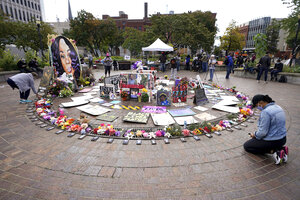Finding justice for Breonna Taylor
Like other cities following police violence, Louisville is relying on a local desire for social harmony and justice to drive needed reforms.

A women kneels in front of a memorial in honor of Breonna Taylor in Louisville, Ky.
AP
Six months after Breonna Taylor was killed in a hail of police gunfire, a grand jury in Louisville, Kentucky, has issued indictments against one of the officers at the scene. The jury’s decision and the protests that followed in Louisville underscore an important point. While incidents of race-based injustice occur nationally, local solutions need to be found where each tragic incident occurs.
The inherent desire in communities to find trust, empathy, and respect for each other can drive demands for individual justice or structural reforms. Building deeper connections within the community is an essential step forward to lessen distrust and violence.
National calls for social justice are needed. Yet these days, with cellphones enabling bystanders to capture violent police encounters, those incidents can provoke raw emotions nationwide. Such outsider perspectives often overlook the unique details of an incident. Protest slogans haven’t always squared with what happened. Local communities are left to decide how to restore social harmony and pursue further justice.
In addition, what’s often overlooked is how people in cities like Louisville; Minneapolis; and Sacramento, California, are working closely together after a violent incident to close the gap between facts and perceptions, however difficult. They are trying to turn division into unity.
For many in Louisville, the indictments did not satisfy a desire to find justice for Ms. Taylor’s death. She was asleep when three officers broke through the door of her apartment shortly after midnight on March 13 to serve a “no knock” warrant on suspicion of drug dealing. Her boyfriend, Kenneth Walker, fired a single shot from a gun he was licensed to own, wounding one of the officers in the leg. The police responded with more than 25 shots. Ten of those came from the gun of Detective Brett Hankison from a blind location in violation of department policy.
The grand jury indicted Mr. Hankison on three counts of wanton endangerment – not for firing into Ms. Taylor’s home, but because some of his bullets passed through walls into an adjacent apartment where a woman and her child were sleeping. Although Ms. Taylor was shot five times, the findings of three separate investigations showed the officers acted within the law.
In working with the grand jury, Kentucky’s attorney general, Daniel Cameron, said he tried to satisfy a demand for justice as best he could within the law because the boyfriend fired first. “The decision before my office as the special prosecutor in this case was not to decide if the loss of Ms. Taylor’s life was a tragedy. The answer to that question is unequivocally yes,” Mr. Cameron said. “My job as the special prosecutor in this case was to put emotions aside and investigate the facts to determine if criminal violations of state law [resulted] in the loss of Ms. Taylor’s life.”
As a result, Louisville is seeking other aspects of justice. The city's $12 million wrongful death settlement with Ms. Taylor’s family points to other potential avenues for longer-term change. That agreement was tied to police reforms meant to improve officers’ relationships with the communities they patrol. These include an early action warning system to identify officers who violate department regulations, a ban on “no knock” warrants like the one issued for the raid on Ms. Taylor’s residence, mandatory review of all warrants by a commanding officer, and use of body cameras.
In other cities dealing with recent police violence, similar reforms are either being sought or in place. In Minneapolis after the killing of George Floyd in May, five City Council members have proposed replacing the Police Department with a “Department of Community Safety & Violence Prevention.” In Aurora, Colorado, local leaders plan to ban police from lobbying governments. In Vermont, the Burlington Police Department adopted a community proposal to require officers to intervene to stop unprofessional conduct by a fellow officer. This year’s nationwide pursuit of social justice has set many cities on a steep learning curve.
In the sequence of events that killed Ms. Taylor, both the police and Mr. Walker used guns in a way that follows the conditioned responses of an increasingly armed society. Such impulses need new restraints, best nurtured within a local community where finding common ground is a strong instinct.

